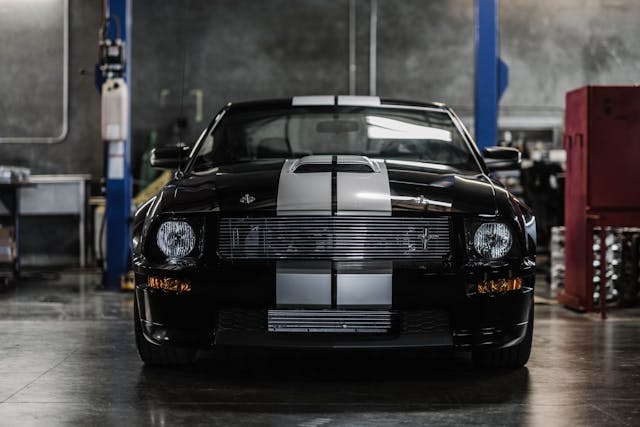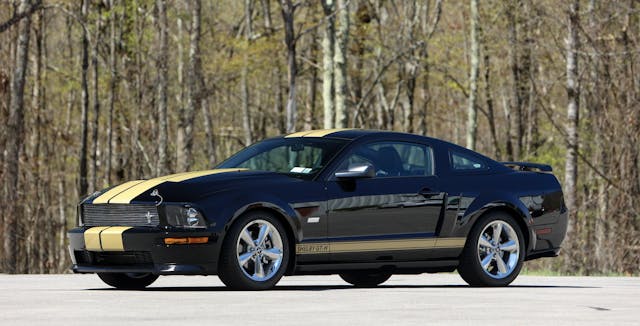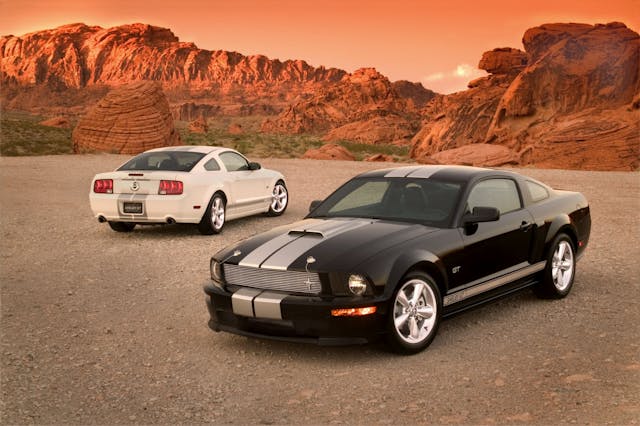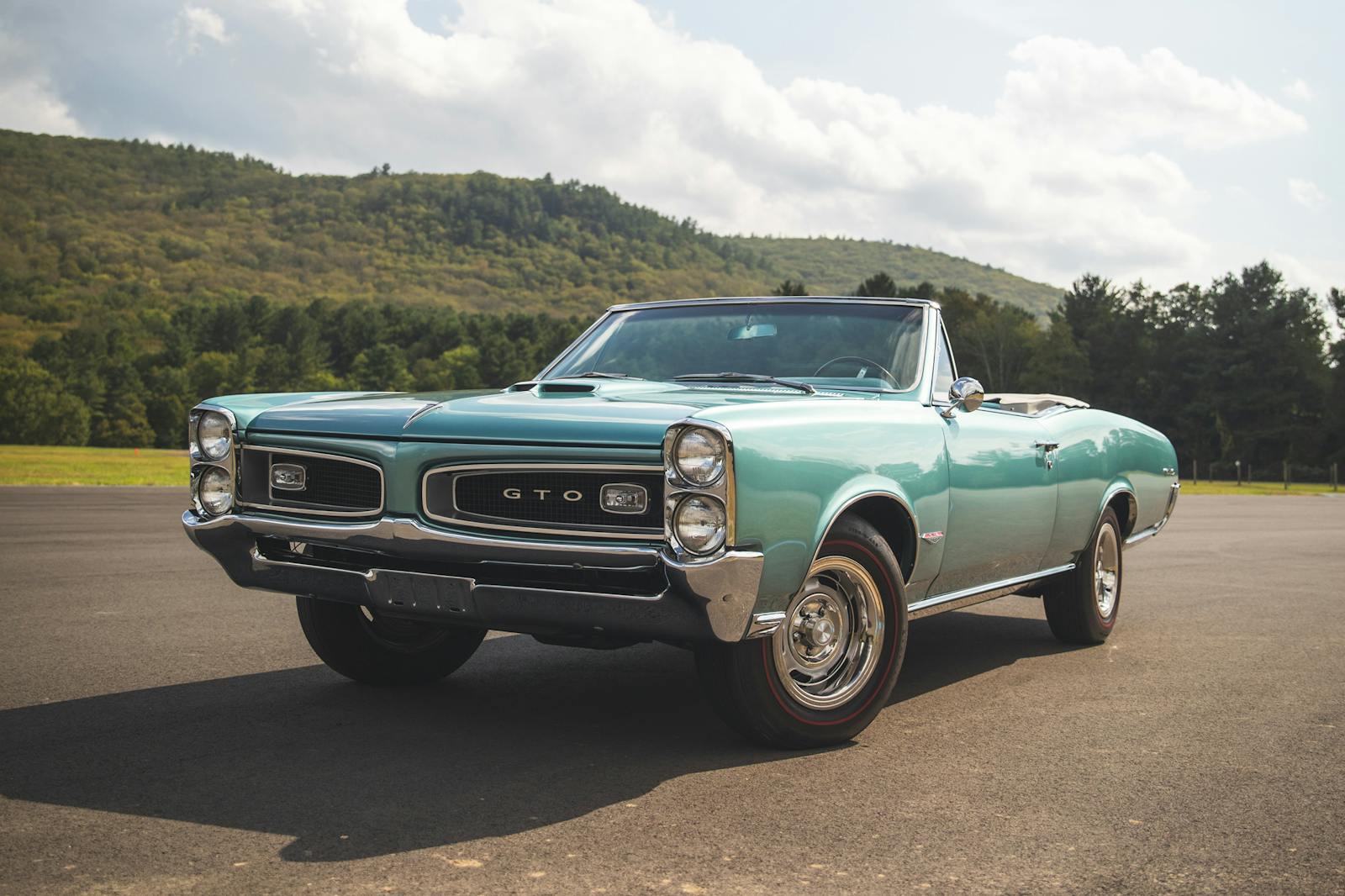Why is the 319-hp Shelby GT hotter than the 500-hp GT500?
Want a better understanding of what’s driving collector-car values? Sign up for the Hagerty Insider newsletter.
Thought experiment:
Two distinctly modern Shelby Mustangs, produced during parallel model years with a set of stripes and goosed-up V-8s. One was a Shelby-licensed Ford factory effort: a comprehensively engineered, 500-hp, supercharged, stick-axle snake that was, for a moment, the most powerful production muscle-car on the planet. The other is a true Shelby-modified ’Stang, marginally more than an aesthetic package with some quality bolt-ons.
Which would you expect to be more collectible? The 500-hp monster, right? Correct!
Well, kind of. Maybe. It’s complicated.

As you probably gleaned from the headline and that pretty pony in the lead image, these mystery Mustangs are the 2007–2009 Ford Mustang Shelby GT500 and the 2007–2008 Shelby GT (SGT). And, if you determine collectability by which trades hands for more cash, then yes, the GT500 is the obvious winner with overall higher values across all conditions, according to the Hagerty Valuation Tool.
The money favors the big, beefy GT500, but something’s happening with the lesser-known Shelby GT. Both ’Stangs have increased their values since 2020, but the understudy SGT has outpaced the GT500 in appreciation.
Pause for a moment—here’s some context before we get nerdy with the numbers. In the mid-2000s, the Mustang brand was arguably the strongest it’d been in decades, with the newly-launched S197-generation Mustang (2005–2013) ushering a surge of sales from a horde of new and returning Mustang owners looking to mainline a fat dose of nostalgia with the S197’s neo-retro design.

The time was right for a Shelby resurgence. Despite a successful turn at hopping-up Omnis, Chargers, and Dakotas for Chrysler, Carroll Shelby’s surname hadn’t graced the decklid of a Mustang in any capacity since Shelby legally re-VIN’d 789 unsold 1969 GT500s as model year 1970. The S197 reawakened Shelby’s relationship with the Mustang, first with the rare 2005 CS6 and CS8 Mustang packages, and shortly thereafter with a 21st-century rekindling of his bonds with Ford and Hertz. The two corporate giants teamed up with the famed Mustang maestro for the 2006 Shelby GT-H, a limited 500-unit run of Shelby-fied black-and-gold Mustang GTs exclusively for Hertz’s rental fleets that recalled the original Shelby-Hertz partnership from 1966.
A year later, Ford and Shelby collaborated again on the 2007–2008 Shelby GT as a commercially-available production version of the former GT-H—which, by the way, returned to Hertz’s fleet for the 2007 model year configured only as a convertible. For SGT production, Ford followed in the spirit of the Shelby Mustangs of 1960s yore by shipping new Mustang GTs straight from the factory to Shelby’s facility in Las Vegas for the hop-up kit.

A new intake, ECU, and exhaust squeezed another 19 hp and 10 lb-ft of torque out of the GT’s 4.6-liter V-8 for a total of 319 hp and 330 lb-ft. Upgraded springs, dampers, and thicker sway bars from a Ford Performance suspension kit significantly improved handling. Aesthetically, the rear spoiler was deleted and a new retro-style hood scoop, chrome five-spoke American Racing-style wheels, a new grille, and rear diffuser were added. Inside, the requisite Shelby commemorative plaque sits on the dash above a classic cue-ball shifter.
So, it’s best to consider the SGT a “Mustang GT-Plus” with Shelby bona fides. It never had its time at the top of the hierarchy however, as the Ford Mustang Shelby GT500 also landed on U.S. tarmac in 2007. Developed almost entirely in-house by Ford’s Special Vehicles Team (SVT) with only consultation and licensing from Shelby, the new GT500 was fully built by Ford at its Flat Rock, Michigan, plant. Differences over its siblings were substantial: a supercharged 5.4-liter V-8 ripped the rear tires with 500 hp and 480 lb-ft of torque, bigger Brembo brakes, and an aggressive suspension with revised springs and dampers to manage the added heft and power. It also sported a vented hood, different front fascia, and rear spoiler, along with its own unique wheels and tires.

But was it a Shelby? Well, according to some diehard Shelby supplicants, no. Despite the name on the decklid and window sticker, some claim this was more SVT than Shelby and had little to do with the “real” cars built in Vegas—nevermind that Ford contracted with Shelby for the later 2008–2009 GT500KR. The SGT, on the other hand, was as Shelby as they come.
Back to valuation. According to our Price Guide, $30,000 will buy a 2007 GT500 in Condition #3—what we consider “Good,” or a, driver-condition car. You’ll find that shopping for a SGT saves you about eight grand over the GT500: $21,800 garners a same-condition Shelby GT.
That delta shrinks to $7000 when comparing Condition #2 cars: $35,600 fetches a SGT while the GT500 averages $42,600. That’s a relatively thin margin compared to the massive gulf in performance and—if we’re being honest—recognition. In Mustang history, the SGT is a well-thought-of B-side to the GT500’s top-40 hit.

Despite that, the SGT does have a few things going for it, principally that it’s dramatically rarer than its big bro. Just 7865 SGTs were built between the 2007 and 2008 model years, compared to the 22,989 GT500s built from the 2007 to 2009. Also, the SGT’s values are gaining traction. Up 44 percent since January 2022, the SGT has outstripped the GT500’s 33 percent increase over the same period.
We’re primarily focused on the two Mustangs available to consumers when new, but Hertz’s GT-H does help provide a little context on what collectors prioritize. With only 500 units produced, it’s rarer than the other two. The nostalgia-advantaged GT-H is up 36 percent over the last year and has surpassed even the GT500 in value. Though they’re very nearly the same car, the values of the two naturally-aspirated GTs bookend their brawnier, supercharged stablemate.
What gives? We get some clues from who buys these hopped-up Mustangs. We don’t break down demographic data for the SGT, but interest in the GT500, as determined by who calls Hagerty for quotes on insurance, disproportionately comes from Baby Boomers. On the whole, they represent just over a third of those calling about insurance—but nearly half of those calling about a GT500. Millennials, on the other hand, don’t seem as interested in the muscle-bound GT500—their share of quotes lags their total market share by seven percentage points. We also see a decent number of GT500s—10 percent in the garages of serious Shelby collectors.
Assuming the breakdown for the rarer Shelby GT is similar—and Hagerty Price Guide editor Greg Ingold thinks it is—then the values make sense. Rarity and authenticity might be more likely to matter to a serious older collector—particularly one who has curated a specific marque—than raw numbers. “Yes, the Shelby GT makes less power and is priced appropriately for that, but it carries the Shelby name and is still quite prized among Mustang and Shelby enthusiasts,” added Ingold. Besides, someone who is really in it just for the power has plenty to choose from. The 2007 GT500 sparked a modern horsepower war that continues to this day with 650-hp Camaro ZL1s, 707-hp Challenger Hellcats, and 760-hp Shelby GT500s.
Will the Shelby GT will cross the Rubicon and join the GT-H with values above the GT500? Time will tell. Whether you choose rarity and Shelby-built provenance or the supercharged powerhouse with a moniker steeped in history, it’s hard to go wrong.
***
Check out the Hagerty Media homepage so you don’t miss a single story, or better yet, bookmark it.



Plus, you get to go to Shelby Club track days
We are surprised that a group nearing or well into retirement is more interested in a legacy brand, retro-styled 2 door vehicle that has a back seat barely capable of holding a backpack?
Corvettes have an image of selling to 45+ year-olds for a reason: people 20-44 are running kids around a lot (if we insist on lumping age groups together and generalizing). They are also lower income/more mortgage/less likely to have multiple toy vehicles.
——-
Hagerty really needs to do some professional development with their entire staff about the modern research around the 1930s “generational theory” and let go of this crutch of a catch-all to make more generalizations about. Much of the white middle class + baby boom generation in Canada and the USA did share a common cultural experience and economic conditions –it is not a reflection of diversity of experience of other people at that time and certainly not since.
It’s a seriously outdated and flawed theory that should not be casually quoted as a truth.
From an insurance quote perspective… just say “people over 50, people 40-49, etc.”. If you want to dive deeper then get into urban/rural and regional differences when you have enough data to justify such (i.e., rural Texans prefer Toyota trucks in 800/1000 quotes…).
This is no surprise, collectibles will never have anything to do with hp. Hp is merely bragging rights, 500hp is something you don’t need unless you think bigger is better, or, if you think more hp equals more pleasure, which is not the case, or, of course, if you are on a track.
Right on! As a boomer I recongnize the critical cultural and financial differences between generations, especially Millenials and Z’s. The great majority can’t afford the rides we could at the same age. That is why they drive Honda Fit’s, bicycles, scooters, and man and dad’s care. They have had a different experience, less hands on and certainly less buying power.
The problem with Shelby GT’s is in the real world nobody knows and really few even care. On the other hand, everyone knows about the performance of the GT500’s.
When I had a 2007 Shelby GT no one seemed to know what they were. Even most Shelby fans didn’t. So you had to explain to them how its a pre title car shipped to Shelby American for modifications. That it was assigned a CSM number and shipped to Ford dealers from there.
So, yeah, the Shelby GT is special since its more exclusive. However, when you have to explain what the car is to everyone it kind of seems like you’re just trying to make up for the Shelby GT’s shortcomings, like the severe lack of performance.
It matters to those with the money.
Can’t imagine not knowing the name Carroll Shelby, American icon legendary in the race car circuit to say the least. I would have loved to own the GT350, as a matter of fact I was able to pick up a black bullitt which may not be highland green but I know less were produced and to note; all you have to say is “Bullitt” and the reply will be; Mustang! I always loved the Shelby Cobra, GT40, and the sweet LX hatch which most of my friends wrapped around poles and ended up on someone’s lawn….. The Mustang needs respect that’s why at 50 I bought the 50th Anniversary edition of the bullitt……. affordable and iconic to the teeth and just enough power for this guy.
Look this has been brewing for a while.
The Vegas Shelby cars are cars that were built by Shelby and while Shelby was alive.
These cars were modified and built to suit the owners and are all very different.
The GT 500 cars are very much jus Fords with a Shelby name plate.
This is not much different than when the original cars were built in California and in the late 60’s they moved to Detroit and were just name plate cars not built by Shelby but converted by a vendor.
The GT500 was expected to be the next SVT Cobra Mustang, after the last ‘Terminator’. Instead, it showed up with the ‘Shelby’ nameplate.
Great Article – Add this to the analysis – There were 3 other special SGTs that weren’t mentioned. The 07 Northern California editions – 202 made, The 08 California Editions (215 Grabber Orange GT-Cs made) and the Black with Red stripes Barrett Jackson editions (100 made). These rare cars will be the standouts and should command higher valuations. Hagerty doesn’t (at last check) mention these cars in their evaluations – they should.
Any data on 2008 SGT convertibles? Very low production numbers, under 600 units.
Anything on the GT/SC? Yes, you can still get the SC package upgrade ( ~500hp) but there are the original one’s with the Paxton Units that there were only about 40ish of?
I have a 08 Shelby GT SC with a Paxton and it has 500 HP I would like to know what its worth.
Hard to believe anything in this article since it started off wrong stating S197 ended in 2013. That must make my 2014 really, really valuable as an imaginary car !
You are right! Now you can believe the rest of the article, as we’ve addressed the error. 🙂
Knew here was a reason I have never had a Ford. Do have the modern equivalent of a pony car, a Cadillac CTS coupe with a useless back seat (does fold down).
Do remember when four doors cost more than two doors but have always preferred smallish overpowered two seaters with DOHC-6s & used to remove chrome and stripes.
One thing not mentioned is the Shelby GT is much quicker around a road course which the original article showed
I guess it’s all about money nowadays, and the love of a car is a distant second.
I remember in the early seventies seeing a white 60’s vintage Shelby Mustang passing me on Interstate 5 with the lettering GT350 on the rockers. Now, that is the only Shelby I want.
I have made some financial mistakes in my life… here is one. When I bought my 2008 Mustang GT the dealer had an 07 SGT with 3, 000 miles on it for the same price. Dumb old me decided that I wanted the brand new car. The little extra horsepower and suspension mods on the SGT did not mean anything to me as I knew that I would modify my GT the way that I would want it. Another reason I chose my GT is that it has daul power seats and the SGT only had a power drivers seat. My wife is short and likes to raise her seat heights. So, I could have had an SGT for the same price as a GT. No regrets as my car is not a garage queen being saved for future value, just thought I would share that.
Have had my 2007 Shelby GT500 convertible for well over 16 years and about 38,000 miles and still love it as much as the day I picked it up from the dealer. It’s a great car, people used to ask to take a picture every time I drove it into a gas station and people still occasionally ask to take a picture of it. In the entire time period, I could probably count on one hand the number of times I have seen another GT500 on the road while driving mine. It’s still not worth what I paid for it and may not appreciate to the sticker + $10K that I paid in my lifetime, but it is still the best automotive buy I have ever made on smiles per mile alone.